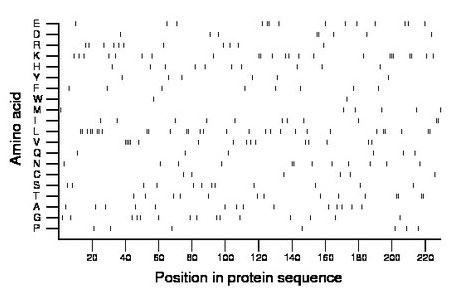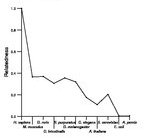
| Name: DIRAS3 | Sequence: fasta or formatted (229aa) | NCBI GI: 4757772 | |
|
Description: DIRAS family, GTP-binding RAS-like 3
|
Referenced in:
| ||
|
Composition:

Amino acid Percentage Count Longest homopolymer A alanine 6.1 14 1 C cysteine 2.6 6 1 D aspartate 3.5 8 2 E glutamate 6.1 14 2 F phenylalanine 3.5 8 1 G glycine 6.6 15 1 H histidine 4.4 10 1 I isoleucine 4.8 11 2 K lysine 10.0 23 3 L leucine 12.7 29 2 M methionine 2.6 6 1 N asparagine 5.2 12 2 P proline 3.1 7 1 Q glutamine 2.6 6 1 R arginine 4.8 11 1 S serine 5.2 12 1 T threonine 6.1 14 2 V valine 6.6 15 4 W tryptophan 0.9 2 1 Y tyrosine 2.6 6 1 |
Comparative genomics:
Search single species RefSeq proteins at NCBI
Search summary 
Figure data | ||
Related human proteins:Protein Relative score Description Self-match 1.000 DIRAS family, GTP-binding RAS-like 3 DIRAS2 0.365 Di-Ras2 DIRAS1 0.340 DIRAS family, GTP-binding RAS-like 1 RAP2A 0.197 RAP2A, member of RAS oncogene family RAP2B 0.193 RAP2B, member of RAS oncogene family RAP2C 0.190 RAP2C, member of RAS oncogene family RAP1A 0.188 RAP1A, member of RAS oncogene family RAP1A 0.188 RAP1A, member of RAS oncogene family RAP1B 0.186 RAP1B, member of RAS oncogene family RAP1B 0.186 RAP1B, member of RAS oncogene family RIT2 0.175 Ras-like without CAAX 2 RRAS2 0.172 related RAS viral (r-ras) oncogene homolog 2 isoform... RIT1 0.166 Ras-like without CAAX 1 RHEBL1 0.163 Ras homolog enriched in brain like 1 RASD2 0.161 RASD family, member 2 RRAS 0.152 related RAS viral (r-ras) oncogene homolog MRAS 0.152 muscle RAS oncogene homolog MRAS 0.152 muscle RAS oncogene homolog KRAS 0.150 c-K-ras2 protein isoform b precursor RALB 0.147 v-ral simian leukemia viral oncogene homolog B RALA 0.147 ras related v-ral simian leukemia viral oncogene hom... KRAS 0.143 c-K-ras2 protein isoform a precursor RERG 0.136 RAS-like, estrogen-regulated, growth inhibitor [Homo... GEM 0.136 GTP-binding mitogen-induced T-cell protein GEM 0.136 GTP-binding mitogen-induced T-cell protein HRAS 0.132 v-Ha-ras Harvey rat sarcoma viral oncogene homolog ... HRAS 0.132 v-Ha-ras Harvey rat sarcoma viral oncogene homolog is... RHEB 0.132 Ras homolog enriched in brain RRAD 0.132 Ras-related associated with diabetes RRAD 0.132 Ras-related associated with diabetesHuman BLASTP results (used to prepare the table) | |||
Gene descriptions are from NCBI RefSeq. Search results were obtained with NCBI BLAST and RefSeq entries. When identical proteins are present, the self-match may not be listed first in BLASTP output. In such cases, the table above has been reordered to place it first.
See About the Figures for the scoring system used in the figure above right. The same scoring system was used in the table of BLASTP results.
Guide to the Human Genome
Copyright © 2010 by Stewart Scherer. All rights reserved.
